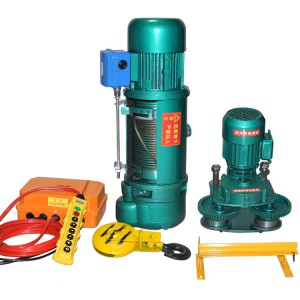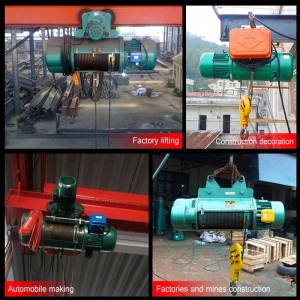1, Since the hoist crane uses a three-phase asynchronous cone brake motor as the power device, the running direction of the three-phase asynchronous motor is related to the phase sequence of the power supply. When the phase sequence of the power supply changes, the running direction of the motor is opposite to the original direction. At this time, when the “down” button of the operator switch is pressed, the spreader will rise, and the limiter of the rising limit position will not work, so it is easy to cause accidents. Crashing accidents such as the crushing of the drum, the extrusion and deformation of the hook group, and the breaking of the wire rope will occur due to the wrong phase. However, the CD and MD electric hoists that are currently produced and widely used in my country are not equipped with wrong phase failure protection measures (which are required to be installed in the electric hoist standard), and there are certain hidden dangers. In the survey feedback statistics, it was found that the failure defects caused by the rope guide and the fire limit position accounted for 20.3% and 17.1%. In addition, in the use of the newly installed electric hoist in the past 1 year, it is found that due to the lack of phase sequence protection, the topping accounts for 30.5%. In order to prevent the lifting injury accident caused by the wrong phase, the wrong phase failure protector should be added in the electric hoist control box. The crane cannot continue to work until the power supply returns to normal. In this way, it can not only prevent the hoisting caused by the wrong phase of the power supply, but also prevent the motor from being burnt when the phase is missing.
2, The fault defects caused by the traveling wheel and the passive wheel account for 2.1% of the fault parts. During the operation of the electric hoist, due to the wear of the wheel rim and the wheel tread, the gap between the wheel and the track gradually increases. If the running gap cannot be adjusted in time at this time, the electric hoist may fall off the track and cause a lifting injury accident. At the same time, due to the particularity of the assembly position of the wheel and axle, the crack of the axle is not easy to be found. When the crack cannot be effectively controlled, the axle may break and cause a fall accident. In order to prevent the occurrence of the electric hoist falling accident caused by this, an anti-shaft breaking protection device can be added at the appropriate position of the electric hoist. The occurrence of serious injury accidents.
3, According to the provisions of GB 6067-1985 “Safety Regulations for Hoisting Machinery”, buffers must be installed at the end of the electric hoist running track, but there is no specific provision for the installation location. At present, the buffer of the electric hoist used in my country is generally installed in the middle part of the I-beam. When the running wheel of the electric hoist collides with the buffer, the buffer plays the role of absorbing energy. However, due to the particularity of the electric hoist structure, when the running wheel rim collides with the buffer, under the action of inertia, the wheel rim wears the buffer extremely seriously. After the electric hoist runs for a period of time, the buffer will lose its original value. Some design features increase the unsafe factors during the operation of the electric hoist, and the stability drops sharply. In order to prevent this failure, the installation position of the buffer can be selected on the lower surface of the I-beam, and the collision between the buffer and the electric hoist suspension ear plate can be used to buffer, thereby effectively prolonging the service life of the buffer.
4, In terms of structural design of electric hoist, although the structural design of CD-type wire rope electric hoist has been greatly improved compared with TV-type wire rope electric hoist, its appearance is poor, the circular structure is inconvenient for installation and transportation, and the shape of the electric hoist is poor. Constraints severely hinder base-type changes. And foreign wire rope electric hoists are mostly of square structure design, which is not only beautiful and easy to install and transport, but also well adapted to modular design, which is convenient for the combination and transformation of basic types, which greatly broadens the scope of use. It is recommended to use high-quality and high-strength steel wire rope. According to the standard requirements of GB/T 3811-2008 “Code for Design of Cranes”, under the premise of satisfying the safety factor of tensile strength, the diameter of the steel wire rope should be reduced as much as possible, and the appropriate drum diameter and wire rope diameter should be used. ratio and the ratio of pulley diameter to wire rope, in order to reduce the structure and weight of the whole machine. In terms of shape design, it is recommended to change the traditional circular design, adopt a square structure, modular design, increase the versatility of components, and change the layout from the original motor-intermediate shaft-reducer-reel form to a motor -Reducer-reel arrangement is beneficial to improve the lifting height of electric wire rope hoist, avoid high-speed shaft long shaft transmission, improve running stability and reliability, and effectively reduce manufacturing costs and increase pulley magnification range , to improve the range of stand-alone use.
5, The electric hoist has deficiencies in the supporting motor. It can be seen from the fault phenomenon table that the fault defects caused by the motor account for 6.6%. Due to the conical rotor motor matched with the CD type wire rope electric hoist, the single speed is 4 stages, the double speed is 1/10 of the mother machine, while the foreign wire rope electric hoist motor adopts a 2-pole motor, and the double speed adopts double winding and variable stages. In this way, the structure is simple, the volume is small, and the self-weight is light, which is beneficial to reduce the manufacturing cost. In addition, compared with foreign wire rope electric hoists, there is a big gap between the insulation level, protection level and noise of the CD-type wire rope electric hoist matching motor. It is recommended to use 2, 4, and 6-pole conical rotor motors in the selection of motors to suit various working conditions. The insulation level of the motor is increased to F and H, the protection level is increased to IP54, and the motor is provided with overheat protection components. In addition to improving the design, processing and manufacturing accuracy of the motor, the noise reduction of the motor should also be considered from the design. Consider reducing electromagnetic noise and air ducts Eddy current noise measures. The design of the motor should also follow the principle of work level division to improve the use of a single machine.
6, It can be seen from the fault location that the fault defects caused by the AC contactor account for 10.3%. The contacts of the existing electric hoist contactor are easy to burn out. The reason is that the equivalent heating current of the motor with repeated short-time duty is too large. In addition, during the conversion process, the commutation is too fast, and the arc freewheeling of the contactor is also likely to cause a short circuit between phases and burn out the contacts of the contactor. In general, the working current of the motor is less than the rated current, although the starting current is 4 to 7 times the rated current, but after all, the time is very short, and the damage to the contacts is not large. When designing the contactor, as long as the contact capacity is greater than the rated current of the motor. 1. 25 times. However, the electric hoist motor is a motor in a special working state, with frequent starting and stopping under heavy load, reverse connection braking, and poor heat dissipation. Therefore, when choosing an electric hoist contactor, according to the general motor design, it does not meet the actual working characteristics of the electric hoist, and the burnout of the contactor is an inevitable result. It is recommended to replace the larger capacity contactor, electric hoist shock load, and heavy load, frequent start and stop, should increase the 2-level capacity when selecting the contactor.
7, Electric hoist should be added with electrical protection measures. In addition to the upper and lower limit protection, overload protection, phase failure protection and voltage loss protection should also be added. Develop models with multiple braking functions such as: double brake (motor cone brake wheel brake + high-speed shaft compensation brake), 3 brake cone brake wheel brake + high-speed shaft compensation brake + reel the safety gate). In the material selection of the rope guide, the high wear-resistant and high-strength rope guide material should be selected as much as possible to prevent accidents such as topping caused by the damage of the rope guide.
Post time: Mar-07-2022






